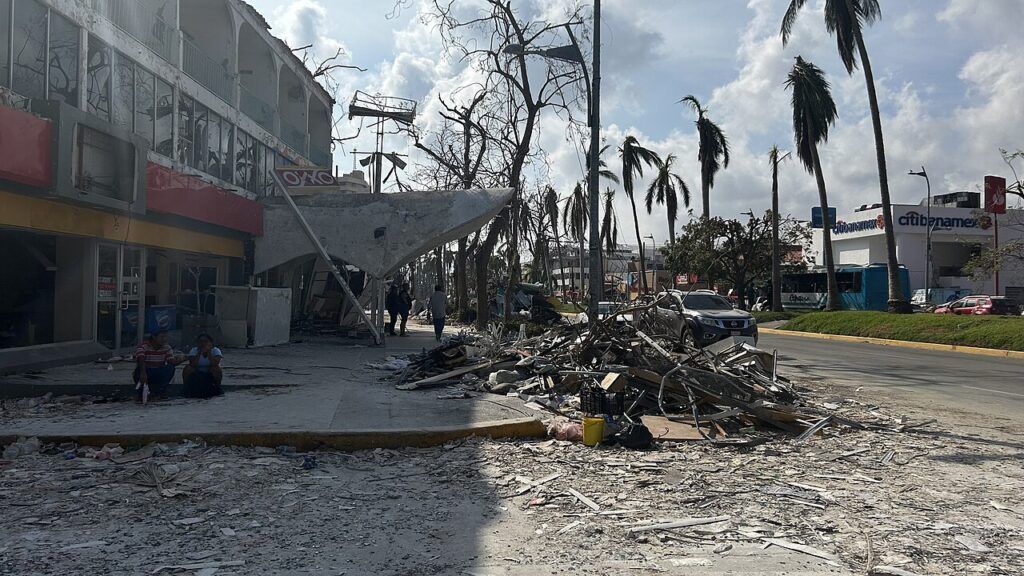New report chronicles toll of climate crisis on Latin America and the Caribbean
By Bob Berwyn | May 22, 2024
 Hurricane Otis damaged or destroyed much of Acapulco, a city of nearly 1 million residents, in October 2023. (Gio Antonio/Wikipedia)
Hurricane Otis damaged or destroyed much of Acapulco, a city of nearly 1 million residents, in October 2023. (Gio Antonio/Wikipedia)
Editor’s note: This story was originally published by Inside Climate News. It appears here as part of the Climate Desk collaboration.
Extreme climate shocks, intensified by global warming, killed hundreds of people and devastated livelihoods and ecosystems across Latin America and the Caribbean in 2023, scientists with the World Meteorological Organization said earlier this week when they released the annual state of the climate report for the region.
Drought, heat, wildfires and extreme rainfall, as well as the strongest-ever landfalling Eastern Pacific hurricane had major impacts on health, food and energy security and economic development, said WMO Secretary-General Celeste Saulo.
Hurricane Otis, which damaged or destroyed much of Acapulco, a city of nearly 1 million residents in October 2023, is emblematic of the growing climate risks faced by the region, she said. Defying most short-term forecasts, Otis intensified in about 12 hours from a weak tropical storm into the strongest hurricane ever to slam Mexico’s Pacific Coast, where it killed more than 50 people and caused billions of dollars in damage.
Recent research suggests that global warming contributes to the rapid surges in hurricane-force winds seen in other recent hurricanes, including Michael in 2018 and Ian in 2022.
Saulo described other severe regional impacts during the last year, including widespread drought that reduced some flows in Amazon rivers to record low levels and also disrupted shipping through the Panama Canal, she said.
The drought and heat waves also helped fuel wildfires across big swaths of South America. In February, fires burned in Argentina’s Iberá National Park, destroying habitat of rare caimans, marsh deer, black and gold howler monkeys and more than 300 bird species. That same month, fires raged across about 1,100 square miles of south-central Chile, which has been gripped by a megadrought since 2010.
Along with last year’s climate shocks, the region is also under pressure from spiraling long-term global warming effects, including accelerated sea level rise that’s swallowing several meters of beach per year in economically critical tourist areas like the Yucatán coast. Climate change is also a key factor in a water shortage in Mexico City, where some neighborhoods are already running out, fueling fears of a citywide water crisis.
“What happened last year was projected by all these IPCC models to happen in 2050,” said coral reef ecologist Lorenzo Alvarez-Filip, based in Puerto Morelos, Mexico. “We thought we had time—‘it will be a problem maybe in 20 years,’—so it was just really, really shocking.”
A Constant State of Disaster Recovery.’ The WMO report revealed one reason why some of last year’s climate shocks in Latin America and the Caribbean may have been surprising: The region is chronically underserved by weather and climate information. According to the agency, about half the countries in the region provide only the most basic weather services, and only 6 percent offer the full services needed to “support decision-making in climate sensitive sectors.”
“This knowledge is needed more than ever, especially in Latin America and the Caribbean, which is the world’s second most disaster prone region,” said Paola Albrito, a disaster risk reduction expert with the office of the United Nations Secretary General.
Overall, she said, about 11 million people in the region were affected by climate-related disasters, resulting in more than $20 billion in economic losses.
“We must reduce the burden of disasters,” she said. “This starts with implementation of … the agreed regional action plan that was updated last year.”
That climate plan provides a regional framework for countries to complete national adaptation plans, as targeted by the Paris climate agreement, and to support their implementation with “robust legal and regulatory, institutional and financial frameworks.”
Several key steps, taken now, she said, could help a lot, starting with integrating disaster risk reduction with development financing to make sure new development is climate-resilient.
Right now, only about 1 percent of official development assistance in Latin America and the Caribbean goes to disaster prevention, “a low level of investment that increases vulnerabilities and keeps many of the region’s least developed countries in a constant state of disaster recovery,” she said.
Strengthening collaboration on regional early warning systems could be the most critical step to saving lives during climate disasters in the short term, including for new disease outbreaks, like dengue fever, that are becoming widespread and could spiral out of control.
And for the long haul, she added, “true climate resilience includes engaging with communities to integrate scientific knowledge with local traditional and Indigenous knowledge.”
The widespread 2023 heat extremes in the region also extended over ocean areas, where coral researcher Alvarez-Filip said the ocean heatwave that spread across the Western Caribbean was almost unbelievable.
“In the whole Caribbean, this is the first time that something that massive happened,” he said. “The ocean temperature at the beginning of August was three and a half degrees Celsius degrees higher than normal. Three and a half degrees is just crazy.”
The heat led to massive coral bleaching, where the partnership between coral polyps and their algal partners breaks down. Unlike previous years, the corals never had a chance to recover in 2023.
“What has happened before is bleaching in September after a warm summer, like in 2015, and then a few die, and then the water cools off in October,” he said. But last year, the ocean didn’t cool off leading to mass coral mortality, he added.
“So we didn’t expect this,” he said. “We didn’t know how a reef affected by such a heatwave would look, even though we’ve seen the news, the papers, all the scientific knowledge from Australia and other places. But here, we didn’t know. We haven’t inspected that, and it was something new.”

Together, we make the world safer.
The Bulletin elevates expert voices above the noise. But as an independent nonprofit organization, our operations depend on the support of readers like you. Help us continue to deliver quality journalism that holds leaders accountable. Your support of our work at any level is important. In return, we promise our coverage will be understandable, influential, vigilant, solution-oriented, and fair-minded. Together we can make a difference.














